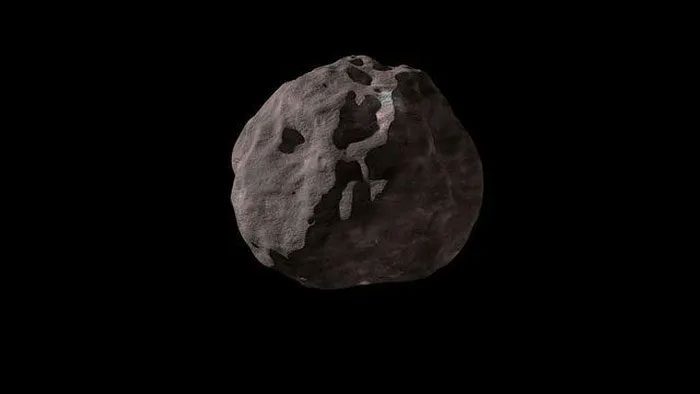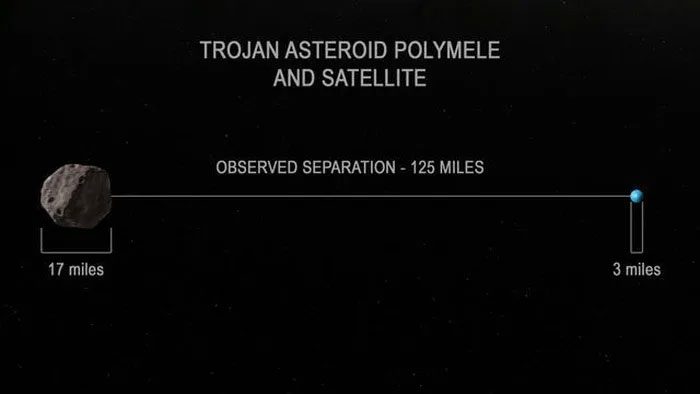Tiny Natural Satellite Discovered Orbiting an Asteroid.
Astronomers may have discovered a “small moon” never seen before in the Solar System: a rocky object orbiting a small asteroid near Jupiter. If this rocky satellite, slightly wider than Manhattan, is confirmed to be a proper moon, it will be one of the smallest satellites ever discovered.
The tiny satellite was discovered by scientists working on NASA’s Lucy mission, which is sending a spacecraft to study several Trojan asteroids—two massive groups of cosmic rocks located on either side of Jupiter in its orbit around the Sun.
The Lucy spacecraft was launched on October 16, 2021, and is set to reach the Trojan asteroids by the end of 2027, after a quick stop in the asteroid belt between Mars and Jupiter. Until then, the Lucy mission scientists will attempt to learn more about some of the mysterious objects in the Solar System to help determine the best landing sites for the spacecraft.

The planets in the Solar System are nothing like Earth. Some planets have as many as 79 moons, like Jupiter, while others, such as Mercury and Venus, have no natural satellites at all.
On March 27, the smallest target among Lucy’s Trojan objectives, known as Polymele, passed in front of a distant star, allowing scientists on the mission to accurately measure the size of the space rock by observing the amount of starlight blocked as the asteroid flew by. However, the research team also noticed a smaller bright spot, resembling a second asteroid trailing Polymele.
After reviewing the data, the team concluded that the second bright spot “must be a satellite,” said Marc Buie, the lead researcher and an astronomer at the Southwest Research Institute in Boulder, Colorado, in a NASA statement.
The newly discovered satellite has a diameter of about 3 miles (5 km) and is located approximately 17 miles (27 km) away from Polymele, at a distance of about 125 miles (201 km). At the time of observation, Polymele was approximately 480 million miles (772 million km) from Earth.
The term “moon” can refer to any natural solid object orbiting a planet, dwarf planet, or asteroid. More than 200 moons have been recognized in the Solar System (excluding asteroids), but the actual number could be much higher, according to NASA.

Unlike Earth, which has only one moon, the number of moons of other planets in the Solar System varies greatly.
Researchers could only make brief observations of Polymele’s satellite, so its orbital path remains highly uncertain. As a result, this space rock has not yet been officially designated as a moon or given an official name. However, researchers are confident that when the Lucy spacecraft reaches Polymele, it will be able to collect enough data to classify it as a true moon.
This is not the first time scientists on the Lucy mission have discovered a satellite trailing an asteroid like the Trojans. In 2021, the research team discovered a 0.6-mile (1 km) wide satellite orbiting Eurybates, which will be Lucy’s first Trojan target. After analyzing data collected by NASA’s Hubble Space Telescope, researchers determined the orbital path of this moon and officially named it Queta.
|
Jupiter has 79 moons. Of these, 72 moons have confirmed orbits, and 52 of them have been named. The largest moons, known as the Galilean moons, were discovered by Galileo Galilei in 1610. They are Io, Europa, Ganymede, and Callisto. Ganymede, the largest moon in the Solar System, is so large that it exceeds the size of Mercury. Saturn has 62 moons. Among them, Titan is the largest, followed by Rhea. Saturn has 24 regular moons and 38 irregular moons. Of these 62 moons, 53 natural satellites of Saturn have been named by humans. Titan is the second-largest moon in the Solar System and is also larger than Mercury. |


















































